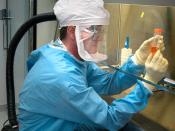PREVENTION OF VIRAL RESPIRATORY NOSOCOMIAL INFECTIONS
Nosocomial infections are one of the biggest problems in post-hospital care. But recently the prevention of respiratory viral nosocomial infections (such as RSV, rhinovirus and influenza) have become the focus of many discussions. So in what ways can we reduce the frequency of viral respiratory nosocomial infections? First we must know the modes of transmission the pathogens use.
RSV is the most important cause of respiratory infection in young children worldwide, infecting virtually every child in the first few years of life. One in every one to two hundred infants requires hospitalization, usually for bronchiolitis. And failure to follow fastidious infection control procedures inevitably leads to nosocomial transmission. And the modes of transmission are listed as respiratory secretions, inhalation of aerosols, indirectly by hands, handkerchiefs and eating utensils or other items freshly soiled by respiratory discharges. And viral shedding may persist for several weeks after symptoms are no longer present.
Influenza type A or B viruses cause epidemics of disease almost every winter. And is a very substantial threat to hospitalized patients despite the existence of a fairly effective vaccine. In the united states approximately twenty percent of people with an average of thirty six thousand deaths and nearly four times that many hospitalizations.
Influenza type A can be found in many different types of animals and, in rare cases, can be transferred from animals to humans. Chickens, ducks, pigs, horses and whales are the common carriers for Influenza type A. Although it is unusual, there is also the possibility of the human and animal viruses infecting the same animal or human. In this case the virus may mutate, mix, and create a new virus. The Influenza type B viruses only circulate among humans.
Rhinovirus, though not as serious as RSV or influenza,


